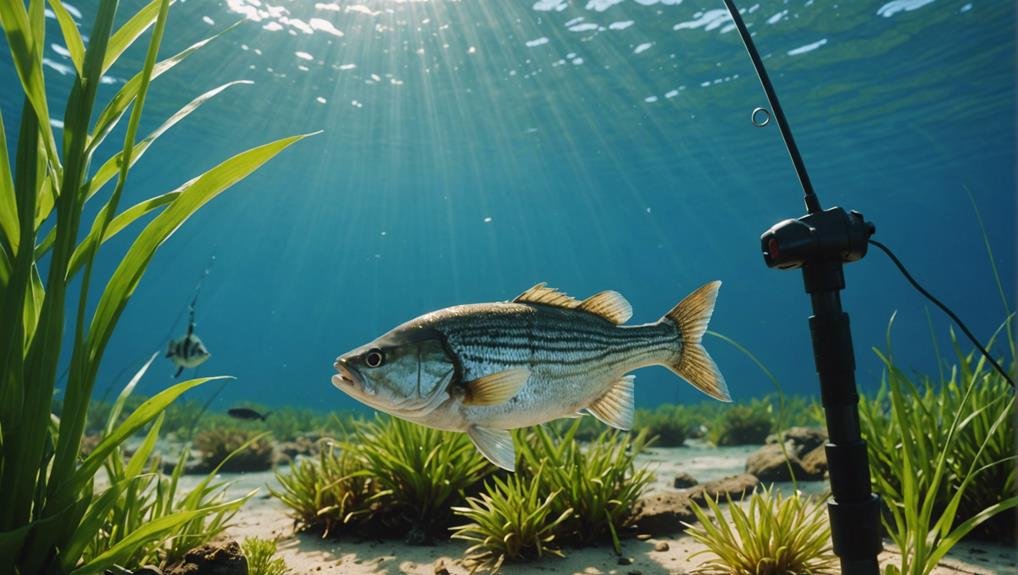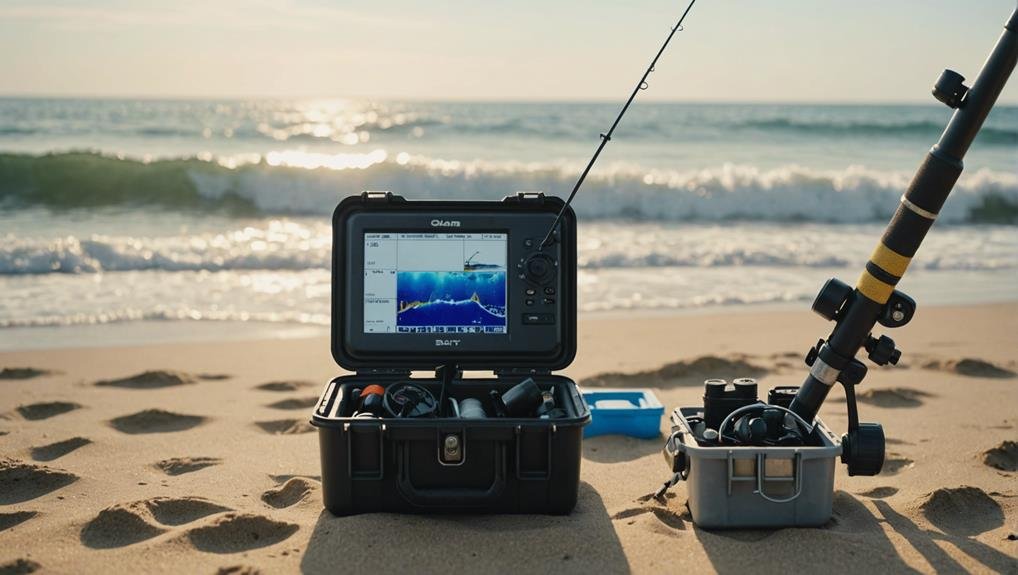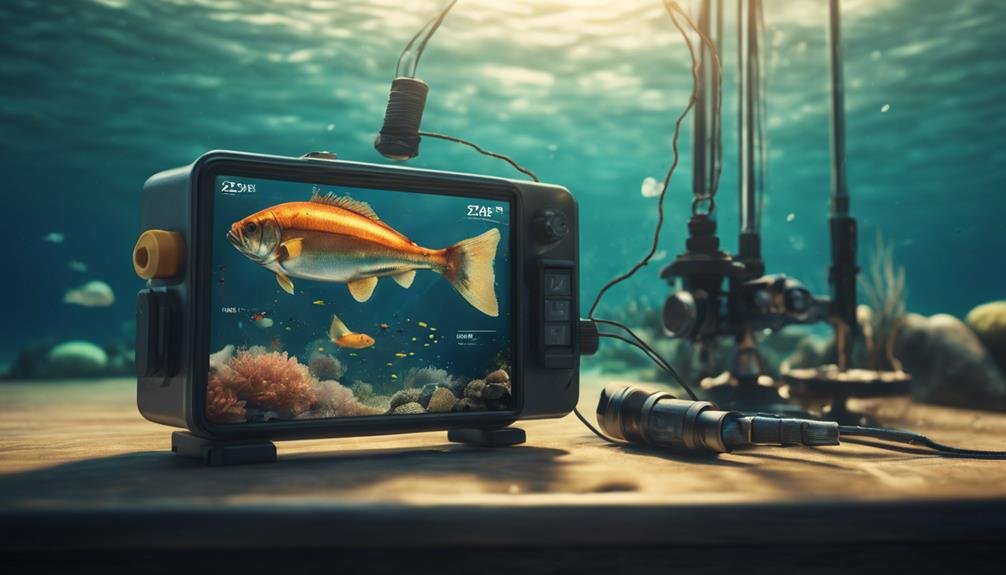The Fish Finder Rig becomes an invaluable tool in your tackle box when surf fishing and aiming to catch bottom-feeding fish. This setup, featuring a pyramid sinker that stirs up sand, keeps your bait near the ocean floor where these fish are most active. Its design allows for natural bait movement, greatly enhancing your chances of a bite. You’ll appreciate its direct connection, giving you the sensitivity to detect even the smallest nibble. What’s the best way to set up this rig and select the right bait for your target species?
Key Takeaways
- The Fish Finder Rig maintains bait near the bottom using a Pyramid Sinker, ideal for surf fishing bottom-feeders.
- Circle hooks and steel leaders are essential to prevent line cutting and ensure secure hook sets.
- Cut bait like mullet and mackerel releases strong scents, increasing attractiveness to fish.
- Pegging a foam float raises bait above the sea floor, making it more visible to aggressive species.
- Adjust bait presentation and experiment with different baits based on tide and water conditions for optimal results.
How the Fish Finder Rig Works

The Fish Finder Rig works by keeping your bait near the bottom using a heavy Pyramid Sinker. This sinker attracts fish by kicking up sand and mimicking a wounded bait fish. This method effectively targets bottom-feeding fish, making it ideal for surf fishing. The Pyramid Sinker keeps your bait in place and creates a sand imitation that appeals to a fish’s natural feeding behavior.
The bait movement is important, as it bounces off the bottom, creating an enticing, lifelike motion that fish can’t resist. The Sinker Slide allows the Pyramid Sinker to move freely along the main line, providing the bait with the flexibility to mimic natural movements. This setup ensures that your bait stays in the prime feeding zone, increasing your chances of a successful catch.
One of the key advantages of the Fish Finder Rig is the direct connection to the rod. When a fish strikes, the force is immediately transmitted through the main line connection, directly linking you to your catch. This setup enhances sensitivity, allowing you to feel even the slightest nibble and react quickly.
The Fish Finder Rig combines effective bait presentation with top control, making it a top choice for surf fishing enthusiasts.
Essential Tackle for the Rig
When setting up your Fish Finder Rig, you’ll need essential tackle like circle hooks, steel leaders, red beads, sinker slides, and pyramid sinkers. The circle hooks are great for a secure hook set, especially when fishing for average-sized surf fish or even smaller sharks. Attach a steel leader to prevent toothy critters from cutting through your line.
Next, slide a red bead onto your line before adding a Size 6 Sinker Slide. The bead is a buffer, protecting your knot from the sinker’s impact. The Sinker Slide allows the fish to take the bait without feeling the sinker’s weight. Pyramid sinkers are your best option for surf fishing as they anchor well in sandy bottoms, reducing drift.
Cut bait like bunker and mullet works well with this setup for bait. However, using live bait is less practical due to the Fish Finder Rig’s bouncing action along the bottom. A cast net can be a handy tool for procuring cut bait, allowing you to catch fresh bait from the surf.
With this essential tackle, your Fish Finder Rig will be ready to attract and catch various surf fish.
Baiting Techniques

After gathering your essential tackle, let’s explore the best baiting techniques to maximize your success with the Fish Finder Rig. One effective method is cutting bait, which releases a strong scent that attracts fish. Popular choices for cut bait include mullet, mackerel, and bunker. These fish have oily flesh that disperses scent well, making them ideal for this setup.
While live bait can be used, cut bait is often more practical due to the rig’s bottom-bouncing nature. This technique involves your bait moving along the seabed, making it easy for fish to detect. Clams, mussels, squid, and shrimp are excellent options, adding variety to your bait arsenal.
Add colorful beads above the bait on your Fish Finder Rig to enhance your baiting techniques. These beads can attract fish visually, complementing the scent of your cut bait. Combining scent and visual appeal increases your chances of a successful catch.
Pegging a Float
Pegging a float onto your Fish Finder Rig can greatly enhance your bait’s visibility and effectiveness. Adding a Foam Peg Float to your setup raises the bait above the sea floor, where crabs and other crustaceans can easily snatch it away. This method prevents bait loss and improves your bait presentation, making it more visible to target fish.
By pegging a float, you can avoid attracting non-targeted fish like sea cats, often drawn to bait lying on the bottom. Instead, the larger profile of the float when fishing attracts more aggressive species, such as sharks and bluefish.
Here are three key benefits:
- Increased Visibility: The Foam Peg Float elevates the bait, making it more visible to fish cruising above the sea floor.
- Reduced Bait Loss: Elevating the bait prevents crustaceans from stealing it, ensuring it remains intact and effective for longer periods.
- Selective Attraction: The float discourages sea cats and other non-targeted fish, increasing the chances of hooking more desirable species.
Incorporating a float into your fish finder rig is especially useful in challenging surf fishing conditions. It provides a significant advantage in attracting and hooking fish.
Surf Fishing Tips

Mastering surf fishing requires keen observation and adaptability to changing conditions. Adjust your bait presentation based on the tide, water conditions, and the fish species you’re targeting. For instance, Striped Bass bait works well at high tide, while other species might prefer different conditions.
To enhance your Fishing Rig’s effectiveness, use floats to keep the bait off the bottom and away from crabs. Additionally, experimenting with different baits like shrimp, clams, or cut bait can make a significant difference. Don’t forget to adapt to changing conditions—choppy surf or calm seas.
Here’s a quick guide to help you:
| Key Aspect | Tip |
|---|---|
| Best time | High tide for Striped Bass bait; adjust for other species |
| Leader length | Varied length is best; consider a steel leader #80 lb for bigger fish |
| Sinkers | Sputnik sinkers for stability in choppy waters |
Using a surf rod that matches the conditions ensures effective casting. Your leader length can vary, but a steel leader #80 lb is ideal for tough fighters. Lastly, always use Sputnik sinkers to maintain stability in turbulent surf.
Conclusion
Utilizing the Fish Finder Rig in your surf fishing setup will greatly enhance your chances of landing those elusive bottom-feeding fish. By mastering the essential tackle, baiting techniques, and even pegging a float, you’ll increase your success rate considerably.
Remember, the key lies in the lifelike bait movement and the rig’s sensitivity, allowing you to feel every bite. So, next time you hit the surf, don’t forget to rig up with the Fish Finder for a fruitful fishing adventure!
FAQs
What is a Fish Finder Rig?
A Fish Finder Rig is a versatile fishing setup used primarily in saltwater fishing to target species like striped bass, redfish, and other bottom feeders. It allows the bait to move naturally with the current, making it more enticing to fish.
How do I set up a Fish Finder Rig?
To set up a Fish Finder Rig, follow these steps:
- Gather Supplies: You’ll need a leader line, a barrel swivel, a sinker slider (fish finder), a sinker, a hook, and your main fishing line.
- Attach the Sinker Slider: Slide the sinker slider onto your main line. The sinker slider allows the sinker to move freely along the line.
- Add a Bead: Place a plastic bead on the main line after the sinker slider. The bead protects the knot from the sinker’s weight.
- Tie the Barrel Swivel: Tie the main line to one end of the barrel swivel using a strong knot, such as a Palomar knot.
- Prepare the Leader Line: Cut a piece of leader line, typically 18-36 inches long, and tie one end to the other side of the barrel swivel.
- Attach the Hook: Tie a suitable hook to the free end of the leader line. Choose the hook size based on the target species and bait.
- Add the Sinker: Attach a sinker to the sinker slider. The sinker weight depends on the water conditions and the depth you’re fishing.
What are the advantages of using a Fish Finder Rig?
The Fish Finder Rig offers several advantages:
- Natural Bait Presentation: Allows the bait to move freely with the current, making it appear more natural and appealing to fish.
- Sensitive to Bites: The fish can take the bait without feeling the sinker’s weight, increasing the chances of a successful hook set.
- Versatile: Suitable for various fishing environments, including surf fishing, pier fishing, and boat fishing.
- Effective for Bottom Feeders: Ideal for targeting bottom-dwelling species like striped bass, redfish, flounder, and catfish.
What types of bait work best with a Fish Finder Rig?
The Fish Finder Rig is effective with various types of bait, including:
- Live Bait: Such as shrimp, minnows, sandworms, and crabs. Live bait works well as it moves naturally, attracting predatory fish.
- Cut Bait consists of pieces of fish, squid, or other baitfish. The bait releases a scent into the water, attracting fish to the area.
- Artificial Bait: Soft plastic baits and scented lures can also be effective with the Fish Finder Rig.
What are some tips for using a Fish Finder Rig effectively?
To use a Fish Finder Rig effectively:
- Adjust Sinker Weight: Choose the sinker weight based on the current conditions and depth. Heavier sinkers are needed for strong currents and deeper waters.
- Use Fresh Bait: Fresh, lively bait is more attractive to fish. Change the bait regularly to keep it fresh.
- Monitor Tension: Keep slight tension on the line to feel for bites, but allow enough slack for the bait to move naturally.
- Set the Hook: When you feel a bite, give the fish a moment to take the bait fully before setting the hook with a firm upward motion.
- Experiment with Leader Length: Adjust the length of the leader to see what works best in your fishing conditions. Longer leaders allow more movement, while shorter leaders can provide better control.
What kind of fish can I catch with a Fish Finder Rig?
The Fish Finder Rig is versatile and can be used to catch various species, including:
- Striped Bass: Particularly effective for surf fishing and nearshore environments.
- Redfish (Red Drum): Commonly targeted using this rig in coastal waters.
- Flounder: The rig’s ability to present bait near the bottom makes it ideal for floundering.
- Catfish: Suitable for freshwater fishing, especially in rivers and lakes.
- Black Drum: Effective in both coastal and nearshore waters.
How do I maintain and store a Fish Finder Rig?
Proper maintenance and storage of your Fish Finder Rig can extend its lifespan:
- Rinse After Use: Rinse the rig with fresh water after each use, especially after saltwater fishing, to remove salt and debris.
- Check for Wear: Regularly inspect the line, knots, and components for signs of wear or damage. Replace any worn-out parts.
- Store Properly: Store the rig in a cool, dry place away from direct sunlight. Use a tackle box or rig wallet to keep it organized and tangle-free.
- Dry Thoroughly: Ensure the rig is completely dry before storing to prevent corrosion and mold growth.
By following these tips and understanding the setup and use of the Fish Finder Rig, you can enhance your fishing experience and increase your chances of a successful catch.

